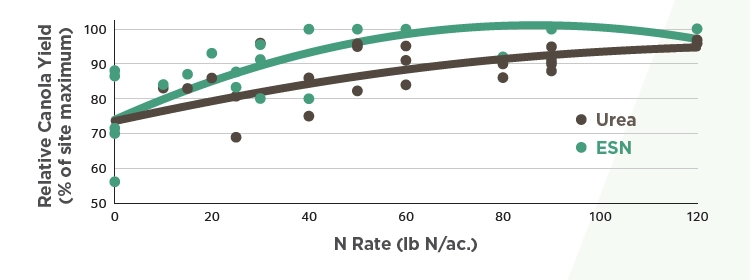
Reduce Clumping in Dry Fertilizer Blends With ESN
Humidity and warm temperatures can cause fertilizer blends to take on moisture over …
Spring Applied ESN Relative to Spring Applied Urea
Research trials were conducted by Agriculture and Agri-Food Canada scientists in collaboration with provincial government researchers at sites across Manitoba, Saskatchewan and Alberta. Research trials ran at various locations to assess the use of ESN – nitrogen (N) as compared to urea – N.
Comparisons were made at the same rate, timing and placement for each N product. Results indicated that yields were maximized when ESN was the applied N source, and that there were trends at some sites in some years for greater oil content (data not shown). Additionally, measurements indicated no differences in maturity or green seed (chlorophyll content) number.
The information shown represents only treatments that were spring applied; there were larger yield differentials favoring ESN, when ESN was compared to fall band applied urea.
The figure presented allows for a relative yield comparison of ESN and urea across all sites and all years. ESN yield is compared to urea yield, relative to the site treatment maximum yield in each year.
On average, across all sites and years (varying environments, soil types/textures and growing season weather, etc.), canola yields were increased between 8 and 10% when ESN was the N source applied. ESN provided available and protected N season long, for full canola development.

| Attachment | Size |
|---|---|
| ESN Is The Smart Nitrogen To Maximize Canola Production On The Canadian Prairies | 599.72 kb |

Humidity and warm temperatures can cause fertilizer blends to take on moisture over …

Recent research in Idaho identified the effectiveness of ESN as the nitrogen source …

For an in-depth discussion on the various nitrogen loss mechanisms and how to …